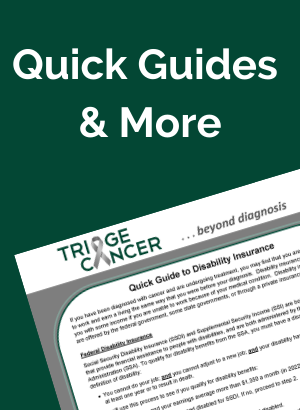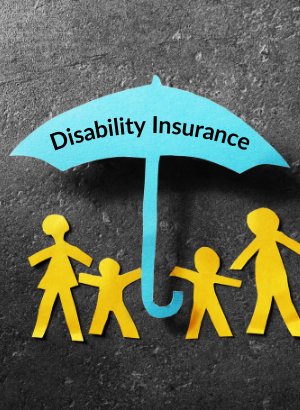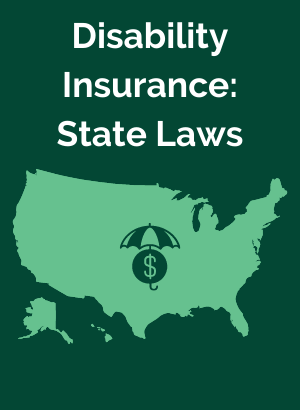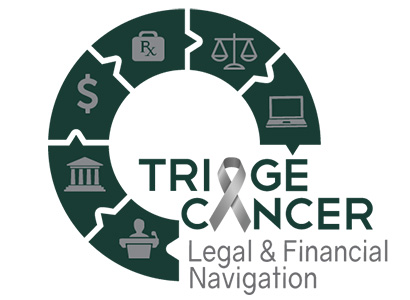If individuals diagnosed with cancer need to take time off work due to their medical condition, disability insurance can help to replace lost wages. This page contains information about disability insurance options, how to apply, how to appeal a denial of benefits, how disability insurance works with other benefits and legal protections, and other important information.
While these materials and resources are designed for individuals diagnosed with cancer, caregivers, and health care professionals, they are helpful to anyone with a serious medical condition, or anyone who wants to learn about their rights.
Quick Guides, Checklists, & Other Materials
These Quick Guides and Checklists will explain the different kinds of disability insurance, when benefits will start, tips for applying and appealing denials of coverage, and things to consider when you are getting disability benefits. These materials present information in a brief, easy-to-digest, printable format to take some of the stress out of this process. If you are looking for a more comprehensive breakdown, see our Practical Guides to Cancer Rights.

- Quick Guide to Disability Insurance
- Quick Guide to State Disability Insurance
- Quick Guide to Long-Term Disability Insurance
- Quick Guide to Supplemental Security Income (SSI)
- Quick Guide to the Timing of Social Security Disability Insurance & Medicare Benefits
- Quick Guide to Navigating SSDI & SSI
- Quick Guide to Transitioning Off SSDI & SSI
- Quick Guide to Taxes and Disability & Retirement Benefits
- Quick Guide to Social Security Benefits for Family Members
- Quick Guide to Disability Benefits for Children
- Quick Guide to Legal Assistance
- Quick Guide to Accessing to Medical Records
- Quick Guide to Crowdfunding
- Checklist to Camps & Adventures
- Practical Guides to Cancer Rights
- Spanish Materials & Resources
Health care professional? Order bulk copies for free!
Animated Videos & Webinars
If you aren't quite sure where to start, we recommend our animated video on “How to Take Time Off and Pay For It” for a brief introduction. And, if you are looking for a more comprehensive explanation of disability insurance, then webinars are for you.
- Animated Video: How to Take Time Off and Pay For It (5:49)
- Webinar: Disability Insurance
- Spanish Materials & Resources
Cancer Finances: Disability Insurance
If you're not sure exactly where to start with disability insurance, this Cancer Finances module is for you! This interactive toolkit will walk you through a series of questions to help you find the information that you are looking for and that applies to you.
State Laws
Understanding state laws related to disability insurance is important, because sometimes they provide more protection than federal laws. Our Chart of State Laws will take you through laws related to disability insurance in your state.
- Chart of State Laws: Disability Insurance
- And don't forget our Quick Guide to State Disability Insurance for additional information
- All Charts of State Laws
One-on-one Help
Triage Cancer has a free Legal & Financial Navigation Program that provides one-on-one assistance on a variety of topics, including disability insurance and employment, to empower you to confidently take next steps.
For Health Care Professionals
These materials are designed specifically for health care professionals helping their clients navigate disability insurance.
More Disability Insurance Tools
Social Security Retirement
- Social Security Administration (SSA)
- Create an online SSA account to view your Social Security statement
- Social Security – Retirement
- Benefits Planner: Retirement
- How Work Affects Your Benefits (after retirement)
Social Security Survivors Benefits
Social Security Disability Benefits
- Social Security – Disability Benefits
- Social Security – Supplemental Security Income
- Social Security – Supplemental Security Income for Non-US Citizens
- Benefits Planner: Disability
- Before You Apply for Disability Benefits
- Checklist for Online Disability Application
- Social Security Disability Benefits – Booklet
- Social Security Disability Benefits – Appeals






